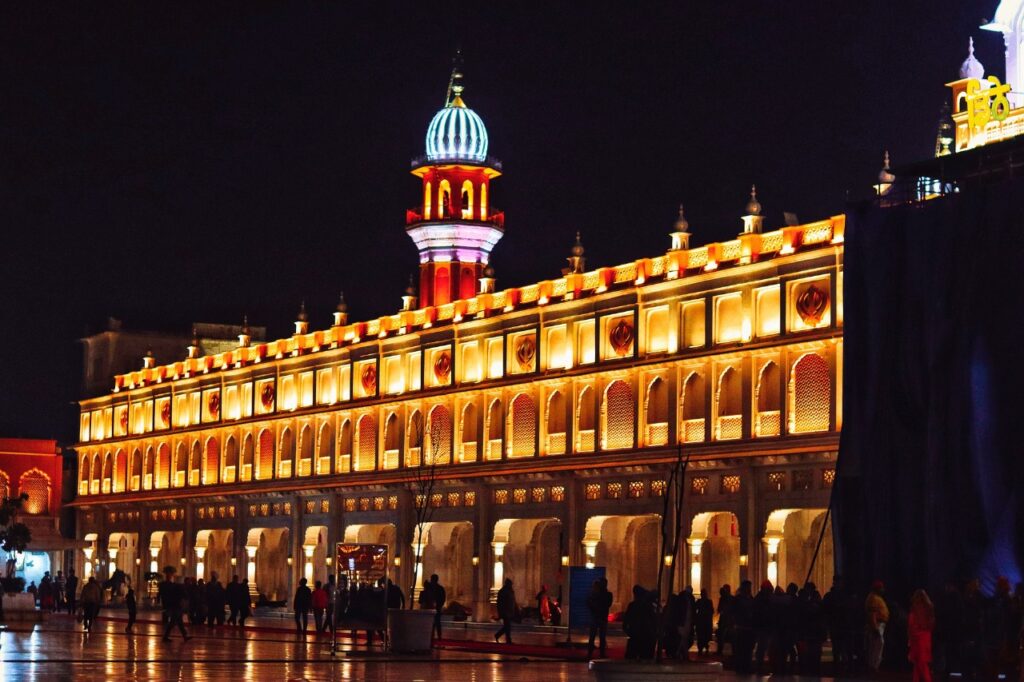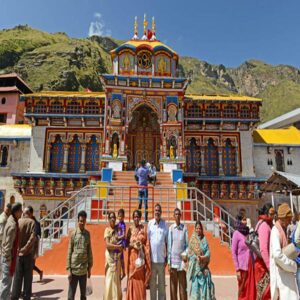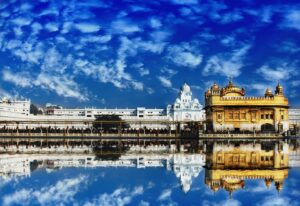Golden Temple is a world-famous and the most sacred holy shrine for Sikhs situated in Amritsar. Amritsar got its name from the lake surrounding the Golden Temple, water of that lake is considered ”Amrit” (meaning holy water) by Sikh people, and ”Sar” means lake!
4th guru of Sikh, Guru Ram Das himself, build this lake.
Lakhs of people come to this sacred Temple from all over the world every day. Golden Temple is also known as Harmindar Sahib, in which ”Har” means ”Every” and ”Mandir” means ”Temple”. Another name of this Temple is Durbar Sahib, which means ”exalted court” in English. From its name to its construction, this Temple signifies that it is open for everyone on a broader level. Anybody is welcome here. Anybody can visit this Temple. Everyone is equal under the roof of the Temple. It’s everyone’s house.
Temple has four open doors on four sides; since old times, Indian society was divided among 4 ”jaati”. These four doors signify that everyone is welcome from all sides, regardless of sector or Religion, caste or gender. Temple’s base is also made in such a manner so that it is a bit lower than the actual landscape. It signifies that one needs to lower their ego when meeting God; we need to incorporate values like humbleness and humility.
According to the historical Sikh records Guru Amar Das, the third Guru of the Sikh tradition, is the one who chose the land which is known as Amritsar now and houses the Harmindar Sahib. He had asked his disciple, Guru Ram Das, to find the land with a man-made pool at its centre to start a new town. Guru Ram das completed building the pool with the help of Baba Buddha. He invited merchants and artisans from other parts of India to settle in the new town, which is since the beginning, a central pilgrimage place and a rallying point for the Sikh community, set within a centre of trade and activity. Construction activity between 1574 to 1604 is noted in ”Mahima Prakash Vartak” (Historical Sikh Text). Guru Arjan is the one who installed the scripture inside the Temple in 1604. He wrote many scriptures of Sikhism, including the popular ”Sukhmani Sahib”, and that is how Amritsar’s Golden Temple became the most prominent Sikh pilgrimage destination. It took eight years to complete the first version of the Harmandir Sahib. Guru’s seat inside Temple is at the lake’s centre, and there is only one way to reach it, signifying that all paths lead to one destination. On 16 August 1604, Guru Arjan completed compiling the first version of the Sikh scripture and placed a copy of the Adi Granth in the gurdwara. He appointed Baba Buddha as the first ”Granthi,” meaning a person, female or male, of the Sikh Religion, a ceremonial reader of the Sri Guru Granth Sahib, the Holy Book in Sikhism.

Since the construction of the gurudwara, many kingdoms tried demolishing it; Mughal and Afghan sultans demolished it many times as it was the centre for Sikh Religion and hence became the centre of persecution, but Sikhs built it back every time! They fought, liberated, stayed back, and rebuilt it every time it was harmed or damaged. The walled courtyard and entrances were added later. Temple is standing tall and proud with its rich history of destruction by foreigners and reconstruction by Sikhs! Every encounter is recorded, and the Temple displays those events on its walls and structures.
Ranjit Singh Era reconstruction was among the most significant construction that made Harmindar Sahib Gurudwara into Golden temple. He paid homage at the Golden Temple and announced that he would renovate and rebuild it with marble and gold. The Temple was renovated in marble and copper in 1809, and in 1830 Ranjit Singh donated gold to overlay the Temple with gold leaf.
There is a traditional story that goes back to the 16th century; it is said that Guru Nanak’s father gave him 20rs and told him to go to the market and build a profitable business, but when Guru Nanak went to the market, he saw many hungry and poor people. He used all that money to feed all those poor souls because he felt that that’s how he could feel great happiness and feel contented. This one act of Guru Nanak became a tradition, and that’s how Langar was formed. Today you go to any Gurudwara, and you will always find a Langar. Langar is a free meal for everyone. Anybody coming to Gurudwara and hungry will be served no matter what Religion or faith you follow, whether you believe in God or not. Any gender, class, caste, or anyone can have this meal. Also, another philosophy that is followed here is whether you are a king or a poor beggar, everyone seats in the same line on the same mat and eats the same food prepared in the langar kitchen. Equality and openness are at the core of the Sikh Religion.
Golden Temple’s Langar is the world’s biggest community kitchen. Daily more than 1 lakh free and delicious meals are prepared for the visitors. At important festivals such as Baisakhi and Diwali, more than 3 Lakhs of meals are prepared. The kitchen always has volunteers who give their labour and time without any expectations, and it is called ”Seva” a selfless service. 24*7 volunteers keep the kitchen going, and there is always food for everyone. Langar has two halls, and 10000 people can have meals at once. If you are hungry, you will get food at any time of the day or night. Bringing people together and closer is one of the core values of Langar tradition.
Amritsar is connected to various cities of India through a good network of road and rail transport. Amritsar also has its airport, which connects the city to many Indian cities and cities of different countries. You can reach Amritsar by road, by air, by train. Visit this historical sacred once in your life is a must.






